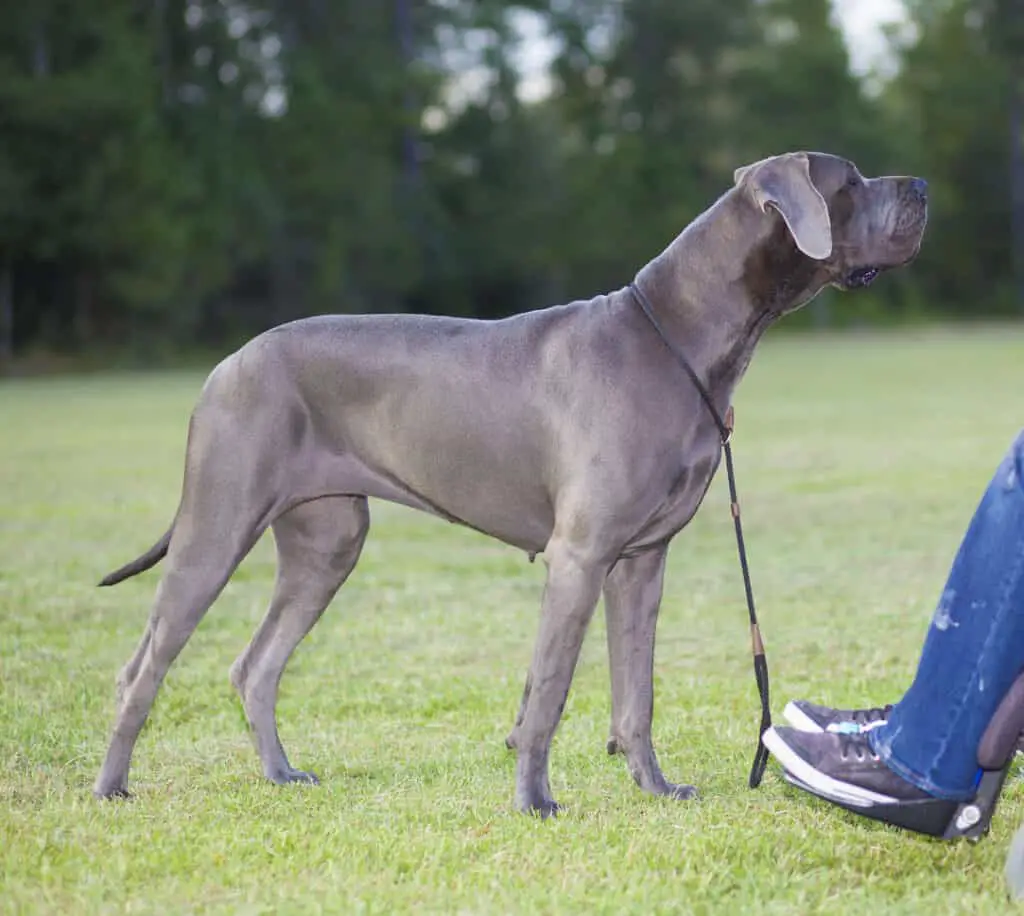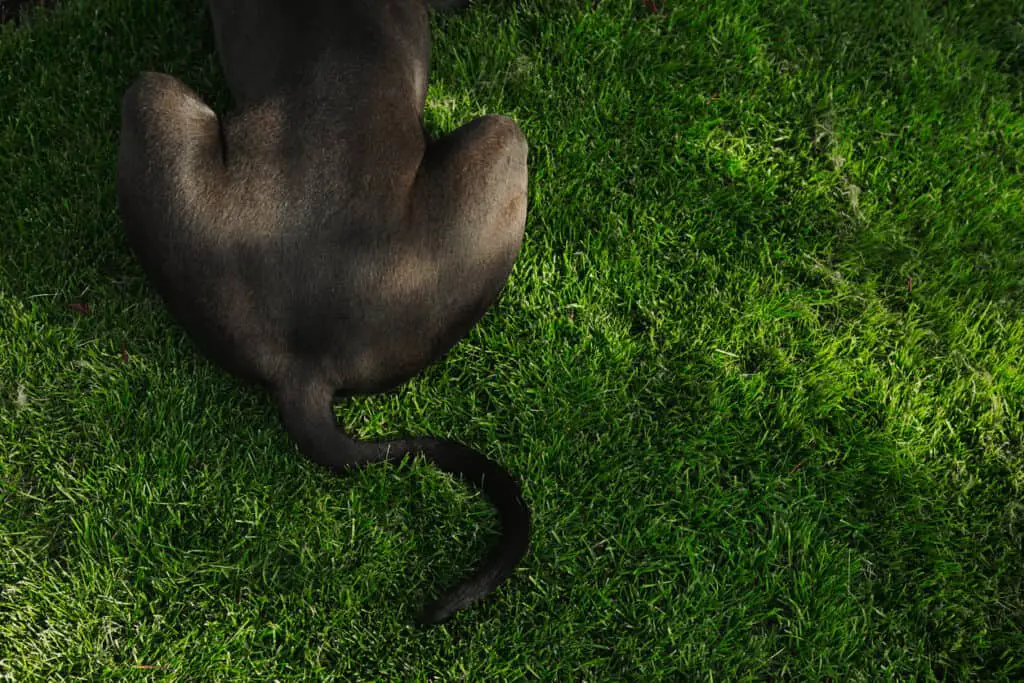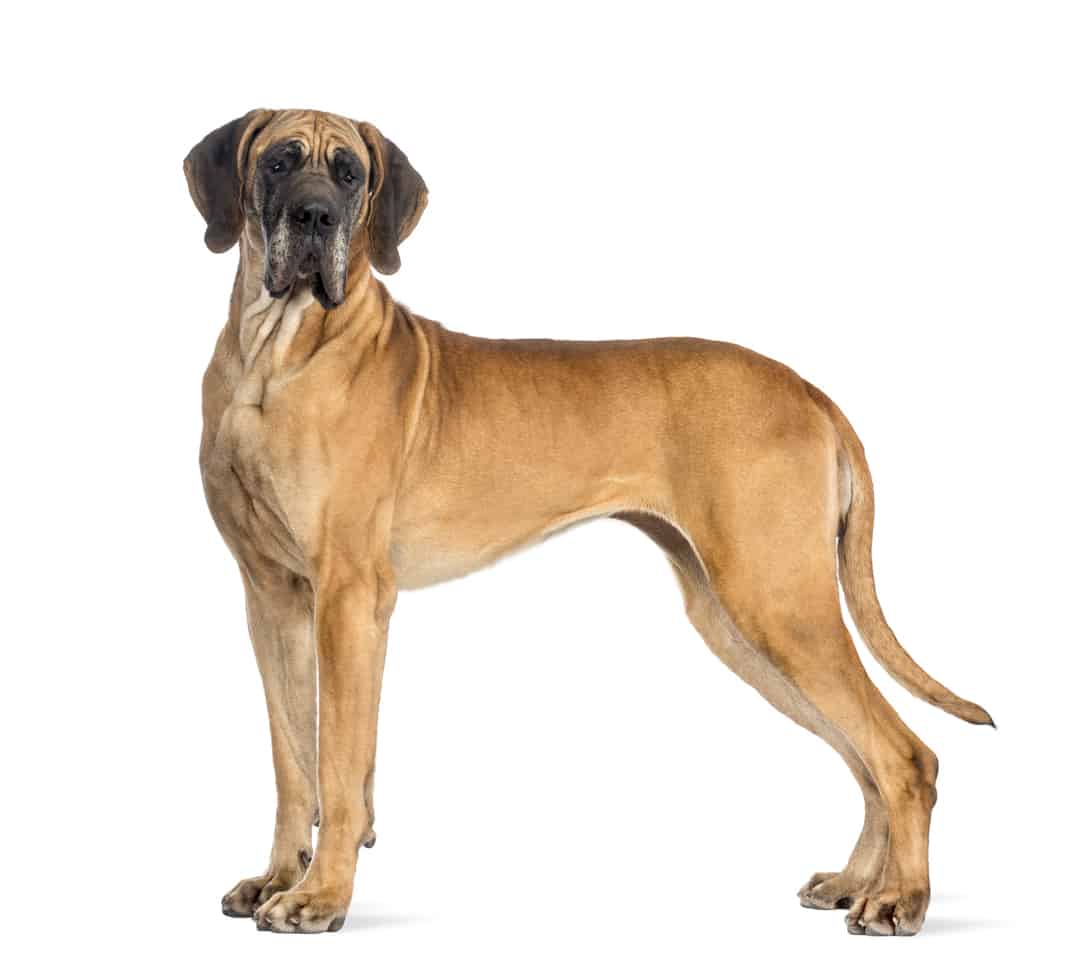Great Danes are legends in the dog world, but their storied history comes with some messy history. Known as the “Apollo of Dogs,” these mighty animals used to chase and hold down boar in the forests of Germany in medieval times. This was a crucial role in the sport of boar hunting because the Great Dane was expected to hold the boar until one of the hunters arrived to finish him off. Hunting was such an important sport that dogs became absolutely integral to the success of a hunt, causing men to look at them in a different light.
Because boar hunting was so dangerous, Great Dane owners sought to minimize the risk to their animals’ lives by altering their physical appearance. Ear cropping and tail docking served as a means of reducing the likelihood that a Great Dane would be harmed on two of its more vulnerable external points.
While this was “good” in the sense that it minimized the risk of harm to a Great Dane during a hunt, in hindsight boar hunting, much like bear baiting and pit fighting, is yet another inhumane “sport.” Today, tail docking is viewed similarly to ear cropping – as an inhumane, cruel, and unnecessary practice.
What is ear cropping and tail docking?

Ear cropping is when part or all of a dog’s pinna is removed from the ear. The pinna consists of the visible portion of the ear on the side of the head and is comprised of the external auditory ear canal. The pinna plays an extremely important role in a dog’s ability to hear. The pinna is responsible for catching sound waves, amplifying them slightly, and then funneling that sound down into the ear canal to the eardrum.
Tail docking is the amputation of part or all of the dog’s tail. A docked tail may also be referred to as a “bobbed tail.” The historic reasoning for this procedure was to reduce the likelihood of a Great Dane being harmed by someone or something biting or grabbing onto its tail, or by getting it caught on something. Although it initially began as a hunting dog, the Great Dane eventually evolved in a guard dog for German nobility, making a shorter tail a logical means of minimizing risk to the dog if it had to fight.
Tail docking and ear cropping is not something that is done only to Great Danes. Many working breeds used for hunting, herding, or the military have historically had their ears cropped and their tails docked as a result of the belief that doing so reduced health complications. For example, tail docking was believed to prevent rabies, strengthen a dog’s back, and increase its capacity for speed and strength. It was also to prevent a dog from soiling itself with its own bushy tail after urinating or defecating.
Over time, docking also acquired a stylish perception and the practice was continued even after the perceived practical benefits were no longer relevant.
Why is Tail Docking bad?

Tail docking is an extremely painful and inhumane procedure. It is considered so archaic that the practice is outlawed in Europe, although not so in the United States and parts of Canada. There are two times when a Great Dane’s tail can be docked: as a puppy or as an adult. A Great Dane puppy may have a rubber band tied around its tail so that the blood circulation is stopped, causing the end of the tail to atrophy and fall off. There are other methods of docking a Great Dane puppy’s tail too, and all of them are performed without anesthesia.
As an adult, the dog will be placed under some anesthesia and the tail will be removed, but there will still be pain when the animal comes out form the anesthesia. There is no situation where this procedure does not cause unnecessary pain and trauma to the animal.
There are also several health risks associated with tail docking. These risks come from the possibility of medical complications and pain associated with the procedure. Risks of docking a Great Dane’s tail include:
- Excessive bleeding
- Infection
- Nerve damage, causing a tumor to develop
- Necrosis
- Lifelong trauma associated with any pain (for puppies that have their tail docked – they are fully conscious when it is done)
Great Danes use their tail to communicate

In addition to health risks, docking a Great Dane’s tail also affects their capacity to communicate. One of the primary ways dogs communicate is via body language, and a key tool in that communication is via their tail. Whether wagging playfully, furiously, straight as an arrow, lowered and off to the side (in the case of intact females in heat), lowered in submission, or any of the other potential ways for tails to be held, a dog’s tail is crucial to it’s ability to communicate.
Great Danes will also use their tails to communicate with other dogs, which is also important for owners to be able to observe their dog’s mood. The tail is also generally used for balance, and during activities such as running, swimming, and jumping.
More and more veterinarians are also starting to refuse requests to dock puppies’ tails, reflecting the growing trend towards leaving dogs’ bodies in their natural state.
Because of the archaic nature of the practice of tail docking, public opinion has shifted, and it is becoming less common outside of conservative circles that still find the appearance of a docked dock cosmetically pleasing. There is also a certain financial element to it, too – any medical procedure performed on puppies or dogs costs money, meaning that those who get their dogs’ ears cropped and tails docked are partially doing so simply because they have the financial resources. Again, this is an old practice that is going out of date.
Additionally, the American Veterinary Medical Association has found no scientific evidence to support the theory that docking provides any health benefits, unless it is medical necessary due to an injury or a congenital defect.
When docking a Great Dane’s tail may be necessary
Great Danes are one of many breeds who suffer from a syndrome called “Happy Tail.” This syndrome affects dogs who wag their tails so furiously that they injure themselves. As ridiculous as it sounds, a dog that is excessively expressive via its tail is at increased risk of injury to its tail.
Knowing that your Great Dane is predisposed to this not-very-happy syndrome can help prepare you to recognize early signs. Recognizing early signs of happy tail is helpful because the earlier you intervene, better for the Great Dane.
Early-stage happy tail is typically marked by bald spots on the tail, Great Dane fixation on the area, or raw-looking patches on the tip of the tail. The giveaway is an open wound, which can bleed anywhere from lightly to heavily.
As soon as you suspect that your dog’s tail may be injured, it’s important to initiate treatment. If you don’t, you run the risk of coming home to stained walls and furniture on account of your Great Dane moving around without regard for the mess its causing. Additionally, the recovery period from happy tail can take several weeks, so the earlier on you’re able to address the issue, the shorter the recovery period will likely be.
What to do if your Great Dane develops happy tail
- Clean and assess the injured area. When an open wound occurs, so does the risk of infection. You can clean your Great Dane’s wound with medicated wipes or dog-safe cleaning solution. Be gentle but firm in your insistence with your Great Dane that cleaning is necessary – it will probably sting and they may not be the most cooperative. Remove any potential contaminants such as blood, dirt, dust, or loose hair that might have gotten into the area.
- Once you’ve cleaned the area, apply antibiotic ointment. This will also help prevent infection and encourage healing. You can also use a special sort of gel known as EMT gel that helps to seal up wounds in general and is recommended to have on hand in your canine first-aid kit.
- This step focuses on preventing an additional or greater injury. A damaged tail can take several weeks to heal entirely, so you’ll have to get creative about how you try to facilitate that healing process. One popular means of doing this is by making a DIY tail-sling that gently suspends a Great Dane’s tail between it’s back legs in order to prevent it from wacking against hard surfaces. Credit for this method goes to GreatDaneLady.
- After your Great Dane’s tail is healed, you will want to be alert for signs of additional injury. Much like Great Danes that bloat, Great Danes that develop happy tail syndrome once are more prone to developing it again. It you haven’t needed to consult with your veterinarian throughout the treatment process for happy tail, you will want to alert them to this the next time you see them. If you are not familiar with treating happy tail in Great Danes, you will likely want to contact your veterinarian from the onset of the syndrome, so that you can work with them to develop a care plan for your Great Dane.
- In some cases, treatment may not be enough to save a tail. In this case, your veterinarian may recommend amputating the tail, which is also known as docking. They will identify where is the best site to make the cut and then remove the unsalvageable part of the tail during the procedure. Your Great Dane will be placed under anesthesia for this, so special care will be necessary when they are coming out of the drug.
In conclusion, deciding whether or not to dock a Great Dane’s tail is much less a personal “style” choice than it is a decision to willfully ignore the evidence that supports leaving a tail intact for the health and happiness of the animal. Great Danes make wonderful family pets and and loyal companions, and part of their allure is their expressive body language. Additionally, to dock a Great Dane’s tail has not been the historic trend, so there is really no benefit at all to doing so. Additionally, when you consider how many expenses Great Danes are likely to accrue throughout their relatively short lifespans, it seems downright unnecessary to add another one to the list of one’s own volition.
If you find the docked tail an attractive look, there are numerous breeds that are born with docked tails due to a genetic mutation. Just a few of these include:
- Doberman
- Rottweiler
- Jack Russell Terrier
- Australian Shepherd
- English Shepherd
- Pembroke Welsh Corgi
Although these dogs are quite different in their look, bearing, and temperament compared to a Great Dane, ultimately, everyone is allowed their own priorities when choosing a dog. If aesthetics rank high on your list and you are a prospective owner who would appreciate having a dog with a docked tail, then choosing a breed where that feature occurs naturally is a great place to begin your search for a canine companion.

